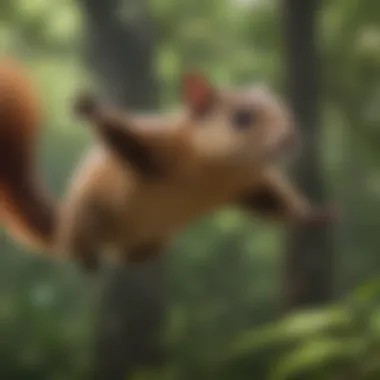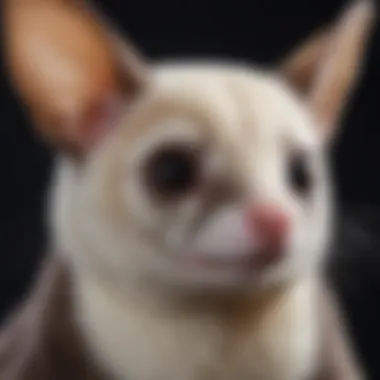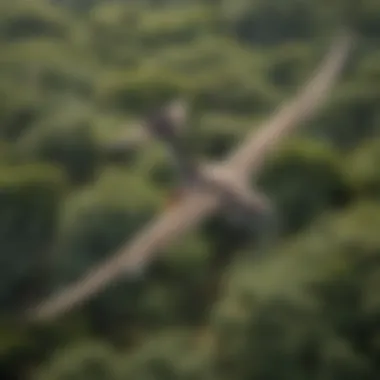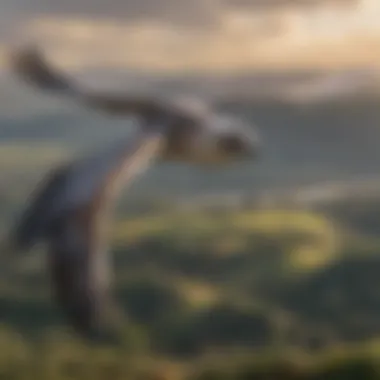Exploring the Enigmatic Glider Animals


Intro
The glider animals exhibit fascinating adaptations that allow them to navigate their environment differently compared to most wildlife. Their unique ability to glide has evolved as a survival mechanism, offering advantages in foraging and predator evasion. This article will explore these remarkable creatures, highlighting various species and their individual adaptations. We will assess their biological characteristics, discuss their habitats, and analyze the growing threats posed by climate change and habitat loss.
As bird enthusiasts, understanding glider animals can enrich our knowledge and appreciation of avian life in general. This exploration will provide a comprehensive overview that can inform conservation efforts and promote a deeper connection to these specialized creatures.
As we delve into the world of glider animals, we will uncover their remarkable capabilities, interactions within their ecosystems, and the pressing challenges they encounter. By synthesizing this information, we aim to present a clearer picture of their significance in nature and the importance of protecting their habitats.
Prolusion to Glider Animals
Understanding glider animals enriches our knowledge of biology and ecology. These creatures showcase fascinating adaptations that allow them to traverse vast distances through the air. Studying them is also crucial in examining their ecological roles and responses to environmental changes. Gliders have unique abilities that provide insights into evolution and survival strategies in various ecosystems.
Defining Glider Animals
Glider animals are generally characterized by their ability to glide rather than fly in a traditional sense. This group includes various species, from flying squirrels and sugar gliders to more unusual examples like colugos and flying fish. Unlike birds, their adaptations often come from membranes or skin flaps that connect limbs, enabling them to navigate their environment efficiently. While not all gliders are mammals, the term encapsulates a diverse range of species that share a common trait of gliding.
The Mechanism of Gliding
The gliding mechanism is primarily based on physics and anatomy. Gliders capitalize on the concept of lift, where the air moving over and beneath their bodies creates an upward force. Structures like skin flaps, stretched between legs, are critical. These adaptations allow glider animals to control their descent and direction. For example, flying squirrels can leap from a height and glide between trees, conserving energy as they forage. The ability to glide offers significant advantages, such as escaping predators and accessing food sources that might otherwise be unreachable.
"Gliding enables various animals to exploit three-dimensional environments, reducing risks and enhancing survival in dense habitats."
The mechanics of gliding are not merely biological; they reflect an evolutionary response to environmental pressures. Furthermore, understanding these mechanisms can shed light on how species adapt to their specific ecological niches.
Types of Glider Animals
The study of glider animals unveils remarkable insights into the ways various species have adapted to their environments. Each type of glider has unique characteristics and adaptations that not only highlight the diversity within this group but also show the evolutionary significance of gliding. Understanding these types is crucial for appreciating the complexity of nature and the ecological roles these animals play.
Flying Squirrels
Flying squirrels belong to the family Sciuridae. They are nocturnal and have developed a membrane called the patagium that stretches from their wrists to their ankles, enabling them to glide smoothly from tree to tree. This adaptation allows them to evade predators and search for food with greater efficiency. Their ability to glide can reach distances of up to 150 feet, making them not only agile but also energy-efficient foragers. The social structure of flying squirrels is also fascinating, as they often live in small groups, which can provide protection against threats.
Sugar Gliders
Sugar gliders are small marsupials found primarily in Australia and New Guinea. Similar to flying squirrels, they have a patagium that aids in gliding. These animals are well known for their ability to glide up to 100 meters. Their diets consist mainly of nectar and fruits, and they have evolved a special digestive system to process these food sources. Sugar gliders are also social animals, often living in family groups. Their vocalizations and social behaviors contribute to their appeal as pets, although they require specific conditions to thrive in captivity.
Colugos
Colugos, or flying lemurs, are unique mammals found in Southeast Asia. Though they are not true gliders, their extensive patagium stretches from head to tail and includes their fingers and toes, enabling them to glide great distances. They have a specialized diet, consisting mainly of leaves, which presents challenges for digestion. Colugos are mostly nocturnal and are excellent climbers, making their way through the treetops of their forest habitats. Their ability to glide elegantly and silently through the canopy minimizes exposure to predators.
Flying Fish
Flying fish exhibit a different kind of gliding mechanism. These fish can propel themselves out of water and glide above the surface for significant distances, sometimes up to 200 meters. They possess elongated fins that resemble wings, aiding their gliding ability. This adaptation allows them to evade underwater predators. Flying fish are crucial for marine ecosystems as they serve as food for various seabirds and larger fish. Their unique adaptations make them an interesting subject for study in both marine biology and evolutionary adaptations.
Anatomical Adaptations for Gliding
The ability of certain animal species to glide represents a remarkable adaptation to their environments. This section examines the anatomical changes that enable glider animals to navigate through the air efficiently. Understanding these adaptations is crucial as they illustrate how evolution can shape physical structures to meet specific ecological needs.


Wing and Limb Structure
The wing and limb structures of glider animals are essential for their unique form of locomotion. These adaptations can be highly diverse depending on the species and the habitats they occupy. For instance, flying squirrels have developed extended skin flaps that stretch between their limbs, which create a parachute-like effect during gliding. This adaptation allows them to slow down their descent and cover greater distances between trees.
Similarly, the colugo, or flying lemur, showcases a different variation. It has an extensive patagium, which is a large membrane connecting its limbs, tail, and body. This unique structure enhances lift and stability while gliding. The flexibility of these limbs can also be noted; glider animals often have robust limb bones designed to withstand the impact of landing and provide the necessary propulsion for launch.
Maintaining these structures requires precise physiological developments, allowing glider animals to control their movements during descents. Their joint mechanics function efficiently to enable quick adjustments mid-air. Thus, this combination of wing and limb adaptations plays a crucial role in their aerial capabilities, enabling them to thrive in their respective environments.
Skin and Membrane Functions
The skin and membranes of glider animals serve multiple vital functions in addition to facilitating gliding. These adaptations are not just about enhancing flight; they also help in thermoregulation and protection. The skin often has a thin, yet tough quality, designed to minimize abrasion during aerial maneuvers.
In the case of sugar gliders, their membrane, known as the patagium, is rich in blood vessels, aiding in temperature regulation. This vascularization is important as these animals may fly in various environmental conditions, necessitating a balance between maintaining body heat and preventing overheating. Moreover, the patagium is elastic, allowing it to expand when the glider leaps into the air, maximizing lift and aiding in aerodynamic efficiency.
Additionally, these membranes can have camouflaging patterns that serve to protect glider animals from predators when they perch on trees. The coloration can blend with their surroundings, making them less visible. Such adaptations indicate an evolutionarily advantageous trait that ties together mobility and safety in their habitats.
"The remarkable features of glider animals highlight their evolutionary journey. Each adaptation is a response to the pressures of survival, emphasizing the intricate connections within ecosystems."
In summary, the anatomical adaptations for gliding in various species reflect complex evolutionary strategies. The wing and limb structures are designed for control and stability while gliding, and the skin and membranes contribute not only to flight efficiency but also to protection and thermoregulation. A deep understanding of these adaptations provides insight into the fascinating world of glider animals.
Behavioral Traits in Glider Animals
Understanding the behavioral traits of glider animals is key to appreciating their unique adaptations and ecological roles. These behaviors not only play a vital part in their survival but also influence their interactions within their environments. Several traits stand out, particularly evasive maneuvers and social interactions, both of which are reflected in their physical capabilities and evolutionary history.
Evasive Maneuvers
Evasive maneuvers are crucial for glider animals, allowing them to escape from predators effectively. Their gliding ability enhances their capacity to navigate complex environments swiftly. Animals such as flying squirrels and sugar gliders utilize their parachute-like membranes to alter their trajectory mid-air, making it difficult for predators to track their movements. For instance, when threatened, a flying squirrel may launch off from a high branch, banking sharply to evade capture. This behavior not only helps individuals survive but also affects population dynamics within ecosystems.
One significant aspect of evasive maneuvers is speed. Gliders can cover impressive distances quickly, gliding as far as 150 meters in a single leap. This behavior is not just about escaping; it also aids in finding food sources and safe nesting spots. By evading predators effectively, these animals improve their chances of reproducing and passing on their genes to future generations.
Glider animals demonstrate agility and speed that are vital for their survival and reproduction, allowing them to effectively navigate their habitats.
Social Interactions
Social interactions among glider animals can vary widely. Some species, like sugar gliders, are known for their social nature. They often live in groups, which can enhance their ability to find food and provide safety in numbers against predators. These communal behaviors do not only enhance survival but also foster social bonds.
The social structure of a group can include a leader, often more experienced in foraging and evasion techniques. This hierarchy helps younger gliders learn and adapt to their surroundings. Additionally, vocalizations play a role in these interactions. Sugar gliders produce various sounds that communicate distress or alert others about food availability. Their social structure highlights adaptability and resilience in facing environmental challenges.
In contrast, other glider species might display more solitary behaviors. For example, colugos tend to be less social and more nocturnal, coming down from trees primarily for feeding, suggesting different ecological strategies.
Ecological Role of Glider Animals
The ecological role of glider animals is multifaceted and significant. These unique creatures contribute to their ecosystems in various ways, from seed dispersal to habitat maintenance. Their ability to glide allows them to interact with different niches within their habitat, making them integral to the functioning of their environments.
Impact on Ecosystem Dynamics
Glider animals influence the dynamics of their ecosystems significantly. For instance, flying squirrels and sugar gliders help in seed dispersal. As they consume fruits and nuts, they carry the seeds to different locations. This activity supports plant diversity and assists in forest regeneration. The landscape can change, depending on the foraging behavior of these gliders. They often feed in the trees' upper canopy, allowing them to contribute to the vertical stratification of the forest. This can help other wildlife as they benefit from the resultant diverse plant life.
Another aspect of their impact is related to their habitats. Glider animals often navigate through complex forest structures. They rely on trees for gliding. When their populations are healthy, they indicate a stable ecosystem. Conversely, a decline in their numbers can signal habitat degradation or loss, affecting other species dependent on the same ecosystem.


Predator-Prey Relationships
The interactions between glider animals and their predators play a crucial role in maintaining ecological balance. Gliders often face threats from birds of prey, snakes, and larger mammals. These relationships contribute to a balanced food web. The presence of gliders can indicate a healthy predator-prey dynamic within their habitat.
As gliders adapt their behaviors, they also help shape predator strategies. For example, flying squirrels possess remarkable evasive maneuvers. This keeps their predators guessing and allows them to escape. On a broader level, these interactions foster biodiversity. The balance between glider populations and their predators can determine the health of their overall ecosystem.
Glider animals serve as both prey and foragers, linking various trophic levels and contributing to energy flow in ecosystems.
Challenges Faced by Glider Animals
Glider animals confront a multitude of challenges that threaten their survival and well-being. Understanding these challenges is crucial to conservation efforts and maintaining biodiversity. The issues surrounding glider species are not just about the animals themselves but reflect the broader health of ecosystems. Addressing these challenges can have significant benefits for wildlife and human environments alike.
Habitat Loss and Fragmentation
Habitat loss is one of the most pressing threats to glider animals. As urban development expands, natural habitats are cleared for agriculture, roads, and buildings. This not only reduces the space available for gliders but also fragments their environments.
Fragmentation can lead to isolated populations. Gliders depend on large, contiguous forest areas to glide effectively from tree to tree. When their habitats become fragmented, they may not be able to access essential resources like food or mates. This isolation can result in reduced genetic diversity, weakening the long-term viability of glider populations.
Some specific ways habitat loss and fragmentation affect gliders include:
- Reduced foraging opportunities: With fewer trees, food resources become limited.
- Increased predation risk: Open areas may expose gliders to predators they would normally avoid.
- Disrupted social structures: Some glider species have complex social interactions that may suffer when populations become isolated.
Efforts to mitigate habitat loss include creating wildlife corridors. These corridors can connect fragmented habitats, allowing gliders to move freely and support their populations.
Climate Change Effects
Climate change presents another significant challenge to glider animals. Changes in temperature and weather patterns can alter the ecosystems gliders depend on. For instance, as temperatures rise, food availability may shift, impacting glider diets.
The primary effects of climate change on glider species include:
- Altered habitats: Rising temperatures may render current habitats unsuitable, forcing gliders to migrate to cooler areas.
- Changing food sources: The plants that gliders rely on may not adapt as quickly to climate change, leading to food shortages.
- Increased weather extremes: Stronger storms can damage habitats and reduce the amount of suitable space gliders have for nesting and foraging.
Research is ongoing to determine the specific effects of climate change on glider populations. Understanding these dynamics is vital for implementing effective conservation strategies.
"Protecting glider habitats and addressing climate change are critical to ensuring these unique animals thrive in their ecosystems."
In summary, the challenges faced by glider animals are multifaceted. From habitat loss to climate change, ongoing conservation efforts and increased public awareness are essential to safeguard these fascinating species for future generations.
Conservation of Glider Species
Conservation of glider species is crucial for maintaining biodiversity and ecosystem stability. Glider animals, such as flying squirrels and sugar gliders, are often reflections of their habitats. Protecting them ensures that other species surviving within the same ecosystems are also preserved. The loss of these remarkable creatures can lead to unexpected consequences in their environments, including shifts in population dynamics and habitat characteristics.
Successful Conservation Strategies
Several effective strategies exist to promote the conservation of glider species. These include:
- Protected Areas: Establishing national parks or reserves helps to safeguard crucial habitats from industrial development or urbanization.
- Habitat Restoration: Engaging in efforts to restore degraded habitats can enhance the living conditions for glider populations. Planting native trees and removing invasive species are examples of this restoration.
- Research and Monitoring: Continuous research allows scientists to track glider populations and health, understanding changes and stressors in their environments. Monitoring programs can provide essential data to make informed conservation decisions.
- Legislation: Supporting laws that protect glider species from poaching and habitat destruction can lead to measurable benefits. These policies often advocate for sustainable practices and environmental stewardship.


Community Involvement in Conservation
Community involvement plays a significant role in the conservation of glider species. Informed communities can become powerful advocates for the preservation of their local flora and fauna. Some notable elements of community involvement include:
- Education Programs: Engaging local populations in educational initiatives can raise awareness about the importance of glider species and broader conservation efforts. Knowledge equips communities to make better decisions regarding environmental practices.
- Citizen Science Projects: These projects allow individuals to contribute to research efforts. By reporting sightings or conducting counts, community members aid scientists in understanding glider populations better.
- Local Partnerships: Collaborating with local organizations or schools can help spread the conservation message, leading to more successful initiatives. People often participate more actively when they feel a connection to the cause.
"Community involvement is not just beneficial; it is essential for sustainable conservation practices. The more people learn about gliders, the more likely they are to protect them."
In summary, the conservation of glider species must be a priority, not only for the animals themselves but also for the health of their ecosystems. Successful strategies are multifaceted, blending legal, scientific, and community efforts to create a comprehensive approach to species preservation.
Research Frontiers in Gliding Animals
Research into gliding animals reveals much about their unique adaptations, behaviors, and the ecological roles they fill. As scientists explore this fascinating group, significant questions arise about their mechanics of flight and evolutionary pathways. Understanding these factors not only contributes to our knowledge of biology but also informs conservation efforts. A focus on research frontiers highlights how gliding animals interact with their environments and what threats they face. Through continuous study, we can enhance our ability to protect their habitats and ensure their survival.
Technological Advances in Studying Gliders
Recent technological innovations have transformed the way researchers study glider animals. For instance, the use of drones has allowed scientists to monitor populations and behaviors from a distance without disturbing the animals. This technology enables detailed observation of their gliding patterns, social interactions, and movements in their natural habitats.
Additionally, advances in genetic analysis offer insights into the evolutionary history of these species. By examining DNA, researchers can track how gliding adaptations have emerged over time. Furthermore, remote tracking devices provide data on migration patterns and habitat usage. This wealth of information enriches our understanding of how gliders adapt to their environments.
Through these methods, scientists can collect comprehensive data sets, leading to more effective conservation strategies. Monitoring health and behavior in real time helps to identify critical areas needing protection.
Future Directions in Glider Research
Looking ahead, research on glider animals will likely expand into several key areas. One promising avenue is the exploration of climate change impacts on their gliding abilities. Changes in vegetation and habitat structure may affect their gliding efficiency and survival.
Moreover, interdisciplinary studies could explore the relationships between gliders and other species within their ecosystems. Such research would clarify the roles these animals play in promoting biodiversity.
Collaboration among wildlife scientists, conservationists, and local communities is essential. Engaging communities in research efforts fosters a shared sense of responsibility for these unique animals. Educational programs can raise awareness about gliding species and their significance, driving conservation actions from the ground up.
In summary, advancing technology and collaborative research approaches are crucial as we dive deeper into understanding glider animals. Uncovering their secrets not only satisfies scientific curiosity but aids in the crucial task of safeguarding these remarkable creatures for future generations.
Closure
The examination of glider animals reveals their remarkable adaptations and the ecological roles they play within various environments. By assessing various species, their behaviors, and the challenges they encounter, this article underscores the significance of understanding these unique creatures. Importantly, glider animals showcase the complex interplay between anatomical evolution and environmental demands. Addressing the factors that influence their survival is not merely an academic pursuit; it is vital for conservation efforts.
To recap, glider animals possess specialized anatomical features that facilitate their gliding ability. Species such as flying squirrels, sugar gliders, and colugos serve as exemplary models of how evolution shapes behavior and lifestyle in response to ecological pressures. Their adaptations not only enhance their mobility but also play a crucial role in their ecosystems, affecting predator-prey dynamics and habitat preservation.
Moreover, the acute threats posed by habitat loss and climate change cannot be overstated. Recognizing these challenges is the first step in fostering successful conservation strategies. Failing to address such threats could lead to declines in glider populations, ultimately impacting the broader ecological community.
Recapitulation of Key Points
- Glider animals demonstrate outstanding adaptations that enable them to glide efficiently.
- Different species exhibit unique anatomical features and behaviors that serve various ecological functions.
- Habitat loss and climate change are key threats affecting glider populations, necessitating concerted conservation actions.
Understanding the fascinating world of glider animals not only enriches our knowledge of biodiversity but also accentuates the importance of preserving their habitats.
Call to Action for Conservation Efforts
The sustained survival of glider animals is crucial not just for their populations but also for the ecosystems they inhabit. It is imperative that stakeholders—be they governments, conservation organizations, or individual citizens—take active steps toward protecting these unique species.
Here are some recommended actions:
- Support local conservation programs focused on habitat preservation to ensure that glider animals have safe spaces to live and thrive.
- Engage in community efforts that promote awareness about the plight of these species. Public education is key to fostering respect and understanding.
- Advocate for sustainable practices in land-use policies to curb deforestation and minimize habitat fragmentation.
By participating in these efforts, we can contribute significantly to the conservation of glider animals and ensure that future generations can appreciate their unique adaptations and the vital roles they play in our ecosystems.















